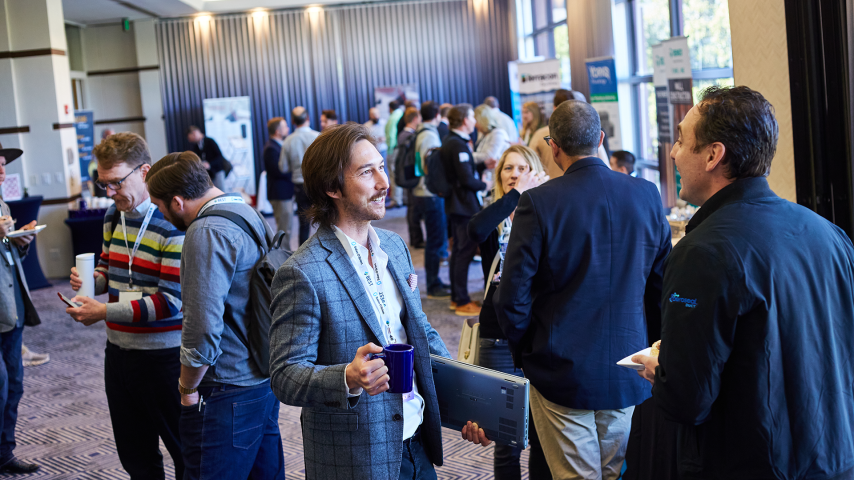
After a six-year hiatus, NIBS brought back the in-person Building Enclosure Science and Technology conference on March 19-20.
Building enclosure experts and BEST6 attendees didn’t miss a beat.
The conference took place at the Sheraton Austin Hotel at the Capitol in Austin, Texas.
This year’s theme was “The Next Generation of Building Technology,” focusing on building safety, resilience, durability, sustainability, and occupant comfort in two tracks: building science and building practice.
Technical sessions covered everything from optimizing retrofitting and increasing building performance to monitoring for design resilience and challenges of practice.
BEST6 keynote speaker, Sam Rashkin, Founder of Housing 2.0, discussed why climate change is an existential threat and how reducing carbon emissions plays a crucial role in righting this ship.
Low-carbon buildings have the capacity to change everything, he said.
“Humans have to drastically reduce carbon emissions,” Rashkin said. “There’s no way around it. Building science is critical to low-carbon buildings. Low-carbon buildings are where life happens better.”
BEST6 Highlights
Conference attendees had access to a wide range of educational sessions. Highlights included, but were not limited to:
- A Mid-Century Gem Goes Net Positive, Jeff Speert and April Ng, 4EA Building Science
- Petrified Forest: Midcentury Historic Rehabilitation, Noah Winkler, Hennebery Eddy Architects, Inc.
- The 4th Industrial Revolution and Work in the Built Environment, Nancy Novak, Compass Datacenters
- Prevention and Mitigation of Interstitial Roof Condensation, Scott Wood, VaproShield
- Carbon and Energy Impacts of Roof Insulation: The Whole Life Story, Elizabeth Grant, GAF
- ASHRAE 90.1 2019 - Impacts on the Design, Construction, and Testing of Air Barriers, Lee Durston, BPL Enclosure
- Low Carbon Insulation Materials to Reduce Buildings’ Carbon Footprint, Som Shrestha, Oak Ridge National Laboratory
- Portland Art Museum - Developing the Glazing System 4.1, Josh Stein, Hennebery Eddy Architects, Inc.
- Super Material: Fiber-Reinforced Polymers (FRP) Cladding, Joshua Zabel, Kreysler & Associates
- A Multicriteria Framework for Low-Income Household Energy Audit Tools, Charles Amoo, University of Tennessee, Knoxville
- Opportunistic Retro: How Existing Buildings Can Cost-Effectively Get to Net-Zero, Deane Evans, New Jersey Institute of Technology
- Climate Positive Enclosures: Priorities and Process: Mark Perepelitza, BRIC Architecture Inc.; Brittany Coughlin, PE, Principal, RDH Building Science; and Ruwan Jayaweera, PE, Principal, PAE Engineers
The Mixed Results of Weathering Wood
In a session on the first day of BEST6, Graham Finch, with RDH Building Science Inc., presented on Managing Aesthetic Expectations from Weathering of Wood Claddings with Clear Finishes.
“We’re seeing more wood being used in exposed locations with mixed results,” he said. “Wood claddings are excellent building science litmus paper. You can tell where it’s wet … [where there is] fungal and mildew growth. We’re seeing bigger and bigger projects exploring the use of wood.”
The desire nowadays seems to be modern wood claddings with clear finishes. Finch said the “ultimate holy grail is uniform natural weathering, which is very hard to achieve.”
Wood cladding maintenance is a lot of work, and the reality is that time and weather erodes most finishes into a mixed palate.
Cedar finishes, for example, typically have a one-to-three year expected service life.
Finch’s conclusion: It’s useful to compare performance of different stain types and see failure mechanisms to estimate maintenance requirements. Proceed with caution when selecting new modified woods, alternate species. Things may look different.
Advanced Building Technology in a Carbon-Free Smart City
Conference attendees learned about the project and tools being utilized for The Line in Saudi Arabia’s Neom, which is being called a revolution in urban living.
The Line will have no streets, cars, or carbon emissions, and it’s expected to run on 100% renewable energy. It will be 110 miles long – on a footprint of just 34 square kilometers – and eventually will accommodate nine million people.
It has been designed as a series of unique communities with daily essentials and efficiencies within walking distance. There are also plans to have high-speed rail with end-to-end transit within 20 minutes.
To Our BEST6 Sponsors: Thank You
BEST6 was made possible through the generous support of our sponsors.
These include Tremco Construction Products Group; Kingdom of Saudi Arabia; Salas O'Brien; Wiss, Janney, Elstner Associates, Inc.; International Institute of Building Enclosure Consultants; Compass Datacenters; Air Barrier Association of America; AIA Austin Building Enclosures Council; Prosoco; Tenmat; York Flashings; Terracon; AABC Commissioning Group; Architectural Record; and Greenroofs.com.




